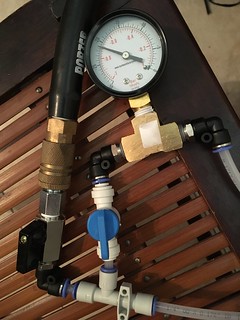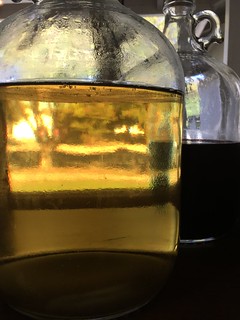I am close to racking my first 5gal batch.. i am going to my local winery tonight to pick up a few things, and was wondering if i should buy a pump that attaches to the airlock used for degassing. i heard it is recommended to degas before bottling, but do you degas after racking or anytime during secondary?
You are using an out of date browser. It may not display this or other websites correctly.
You should upgrade or use an alternative browser.
You should upgrade or use an alternative browser.
degas in secondary
- Thread starter TimKonn2
- Start date

Help Support Homebrew Talk - Beer, Wine, Mead, & Cider Brewing Discussion Forum:
This site may earn a commission from merchant affiliate
links, including eBay, Amazon, and others.
myndflyte
Well-Known Member
Using a pump to degas sounds like a recipe for disaster. New mead maker here so anyone else chime in. If you are going to degas, you're going to want to do it during the first part of fermentation. And if you are going to degas, you just use something like a drill attached whip like this: https://www.northernbrewer.com/mix-...PbjwR2DzdZOz_TF2JoCnrf356RaIb3hRoCncYQAvD_BwE
Using a pump to remove gas from 5 gallons would take forever, not to mention the potential disaster that could result from creating a vacuum in your bucket/carboy.
From what I understand, if you're already to rack it to a secondary, I don't think you're going to want to degas because you could just be adding O2 which would speed up oxidation.
Using a pump to remove gas from 5 gallons would take forever, not to mention the potential disaster that could result from creating a vacuum in your bucket/carboy.
From what I understand, if you're already to rack it to a secondary, I don't think you're going to want to degas because you could just be adding O2 which would speed up oxidation.
myndflyte
Well-Known Member
Oh if you already did that, then I think you should be fine. The small amount of gas dissolved in the liquid should not be enough to cause bombs or popped corks. You're main concern there is from the mead not being done and it ferments more.
bernardsmith
Well-Known Member
What is the gravity? If your yeast reached bedrock (more in a moment) and you are not adding any more fermentables then there is really no need to stabilize with K-sorbate. Adding K-meta (the active ingredient of Campden tabs) will inhibit oxidation and so allows your mead to age gracefully.
The problem is that a finished gravity of 1.000 means that in fact there is some residual sugar in the mead. "How come?", you ask. "Water has a gravity of 1.000 so a mead with a gravity of 1.000 has no sugar".
Not so. The gravity (density) of alcohol is lower than 1.000 so if there is any alcohol in your mead (and there ought to be) then alcohol + water should have a gravity below 1.000. And in fact it is possible for a mead to end with a gravity lower than 1.000. That does not mean that all the sugars are in fact easily fermentable. They may not be and the yeast may not ferment them for a year or two... But the yeast can and they often do... so unless the gravity is about .980 - .960 you MAY want to stabilize the mead.
The problem is that a finished gravity of 1.000 means that in fact there is some residual sugar in the mead. "How come?", you ask. "Water has a gravity of 1.000 so a mead with a gravity of 1.000 has no sugar".
Not so. The gravity (density) of alcohol is lower than 1.000 so if there is any alcohol in your mead (and there ought to be) then alcohol + water should have a gravity below 1.000. And in fact it is possible for a mead to end with a gravity lower than 1.000. That does not mean that all the sugars are in fact easily fermentable. They may not be and the yeast may not ferment them for a year or two... But the yeast can and they often do... so unless the gravity is about .980 - .960 you MAY want to stabilize the mead.
myndflyte
Well-Known Member
I just asked this question today and am in the same boat as you. The consensus was to at least add campden tablets. Here's the thread: https://www.homebrewtalk.com/forum/threads/campden-to-finish-cyser.641066/might as well ask this here also.. What about stabilizing a mead im not back-sweetening? i really dont want to add the chemicals, but if i have to, to prevent bombs.. i hate the internet
Stephmon
Active Member
- Joined
- Oct 22, 2017
- Messages
- 35
- Reaction score
- 8
I vacuum degas my mead in secondary, without issue. So far, I've gotten a 'champagne' bubbling, as my ferment is mostly over by that point (I 'swirl' degas my 1 gallon jugs, during the early ferment). I have seen videos of homemade wine vacuum degas, where the wine looked like a rolling boil (search youtube for "vacuum degassing wine").
I don't use a hand pump, rather I bought a vacuum attachment for my air compressor and I'm happy with the results. I guess I lean this way, instead of the drill powered 'whip', as it is less likely to accidentally aerate the wine and at least in theory, vacuum should consistently be able to get more CO2 out of solution.


I don't use a hand pump, rather I bought a vacuum attachment for my air compressor and I'm happy with the results. I guess I lean this way, instead of the drill powered 'whip', as it is less likely to accidentally aerate the wine and at least in theory, vacuum should consistently be able to get more CO2 out of solution.


yea, i aerated til 1/3 and degassed till about 1/2 sugar break using a drill..love it.. My main concern is getting all the co2 in secondary out before bottling to avoid bombs, or it that not really necessary?
Generally not before bottling- because the mead is degassed in primary when possible, and then racked a couple of times so no c02 should be building up. If it is you can degas, so you have a still mead (not bottle bombs, as it doesn't continue to build up), but I've only needed to do that one time in 25 years so it's not common to need to do it unless you rush the mead to the bottle.
What is the gravity? If your yeast reached bedrock (more in a moment) and you are not adding any more fermentables then there is really no need to stabilize with K-sorbate. Adding K-meta (the active ingredient of Campden tabs) will inhibit oxidation and so allows your mead to age gracefully.
The problem is that a finished gravity of 1.000 means that in fact there is some residual sugar in the mead. "How come?", you ask. "Water has a gravity of 1.000 so a mead with a gravity of 1.000 has no sugar".
Not so. The gravity (density) of alcohol is lower than 1.000 so if there is any alcohol in your mead (and there ought to be) then alcohol + water should have a gravity below 1.000. And in fact it is possible for a mead to end with a gravity lower than 1.000. That does not mean that all the sugars are in fact easily fermentable. They may not be and the yeast may not ferment them for a year or two... But the yeast can and they often do... so unless the gravity is about .980 - .960 you MAY want to stabilize the mead.
my 5gal traditional should end around 1.000, maybe alittle higher. OG was 1.114 with 7lb yeast. Just pitched a 2.5gal cyser last night with a OG og 1.124 7lb yeast.. taking your info and the info from myndflyte's thread, sounds like i def want to add 1 crushed campden tablet per gallon (hopefully not giving an off taste).. But without the k-sorbate, the campden alone will not prevent random fermentation start? If back-sweetening, i want to add both.
and when adding campden, i can either crush up and add to must or rack into a new carboy on top of crushed tablets? after adding campden, typically how long do you wait till you bottle?
Either works. But crushed Campden tabs don't dissolve easily, so I like to stir them into a cup or two of must in a glass until I see that there's no more particles floating around. You can pour that into your carboy and rack on top of it. No need to wait to bottle.
Either works. But crushed Campden tabs don't dissolve easily, so I like to stir them into a cup or two of must in a glass until I see that there's no more particles floating around. You can pour that into your carboy and rack on top of it. No need to wait to bottle.
ok, so in theory i can dissolve in must, pour into same carboy or pour into new carboy and rack ontop.. and then either bottle right then, or let sit in carboy for however long.. sounds easy enough
Looks more like a Monet than a Degas.
Stephmon
Active Member
- Joined
- Oct 22, 2017
- Messages
- 35
- Reaction score
- 8
Well played sir.Looks more like a Monet than a Degas.
Similar threads
- Replies
- 2
- Views
- 871
- Replies
- 15
- Views
- 776
- Replies
- 7
- Views
- 2K

